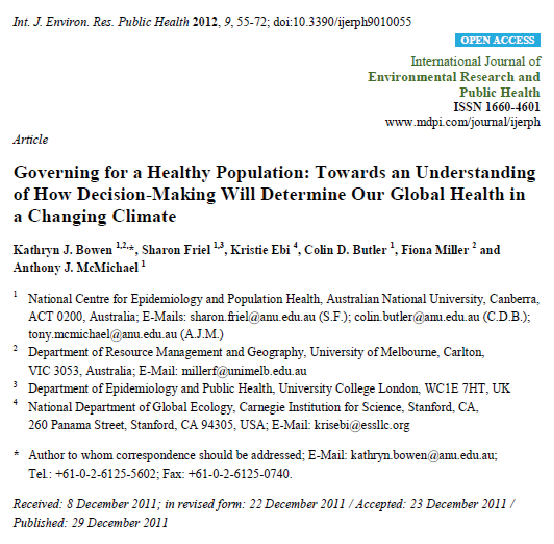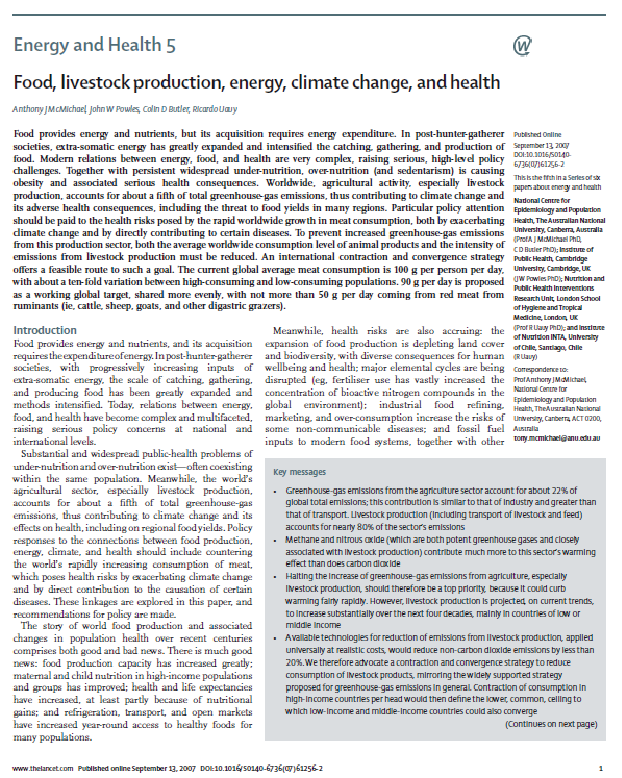Aubrey
You have my full support.
Please add my name to the GCI proposal concerning contract and converge to the UNFCCC.
Best wishes
Colin
PS Are you aware of our paper: McMichael AJ, Powles J, Butler CD, Uauy R. Food, livestock production, energy, climate change and health. The Lancet. 2007; 370: 1253-63. This explicitly argues for a C&C strategy with regard to meat consumption.
Associate Professor Colin D. Butler PhD, MSc (epidemiology), BMed, BMedSci(Hons), DTM&H, DLSH&TM Associate Professor ANU College of Medicine, Biology and Environment
How Climate Change is Linked with the Social Determinants of Global Health and Development
The health effects of climate change and other aspects of adverse global environmental change will not be distributed uniformly or fairly. Populations and communities who face social disadvantage (both between and within countries) are likely to bear a greater burden due both to the direct and indirect impacts of climate change, deepening existing vicious circles that entrap the poor.In a fair world, this extra jeopardy would provide extra impetus to address climate change, not least as the most vulnerable populations are those which are least responsible for fossil-fuel combustion and other greenhouse gas emissions. However, an additional layer of complexity exists. The development pathways that most low consumption populations aspire to (in addition to the ongoing aspirations of high consumption populations) are in obvious conflict with carbon budget targets. The great challenge is to provide increased health and well-being in ways that reduce the rate of greenhouse gas accumulation.
This is daunting but not impossible; more active transport in high consumption countries can reduce chronic diseases and reduce carbon emissions, “contraction and convergence” of material consumption, including of animal products can improve health for both rich and poor. Solar and other technologies can provide electricity without harming the climate. Lowering population growth in low consumption countries, through means such as female education, will hasten economic development, enhance climate change adaptation and reduce the eventual scale of greenhouse gas emissions.
Governing for a Healthy Population:
Towards an Understanding of How Decision-Making Will Determine Our Global Health in a Changing Climate
Kathryn J. Bowen, Sharon Friel, Kristie Ebi, Colin D. Butler, Fiona Miller, Anthony J. McMichael
In a recent paper in The Lancet Anthony McMichael and Colin Butler propose that the world should commit to reducing the global average daily intake of meat, especially red meat from ruminants. This would be part of the evolving portfolio strategy across various sectors of commerce, energy use and human behaviour to mitigate climate change. The fairest approach is contraction and convergence, where the world's nations agree to reduce average per-person meat consumption (currently just over 100 grams per day) and to do so equitably. High-consuming populations would reduce their intake and low-consuming populations could increase their intake up to the agreed average level.
Contraction and Convergence is Good for our Health
Food Ethics - Tony McMichael
As has been proposed for greenhouse-gas emissions at large, emphasizing international equity, a contraction and convergence policy seems to be the most defensible—and therefore the most politically feasible—model for restricting emissions arising in relation to consumption of meat and dairy products. Because rapid reductions in greenhouse-gas emissions per unit of livestock production would be technically and culturally difficult in the short term, the prime objective must be to reduce consumption of animal products in high-income countries, and thus lower the ceiling consumption level to which low-income and middle-income countries would then converge.Key messages
- Greenhouse-gas emissions from the agriculture sector account for about 22% of global total emissions; this contribution is similar to that of industry and greater than that of transport. Livestock production (including transport of livestock and feed) accounts for nearly 80% of the sector’s emissions
- Methane and nitrous oxide (which are both potent greenhouse gases and closely associated with livestock production) contribute much more to this sector’s warming effect than does carbon dioxide
- Halting the increase of greenhouse-gas emissions from agriculture, especially livestock production, should therefore be a top priority, because it could curb warming fairly rapidly. However, livestock production is projected, on current trends, to increase substantially over the next four decades, mainly in countries of low or middle income
- Available technologies for reduction of emissions from livestock production, applied universally at realistic costs, would reduce non-carbon dioxide emissions by less than 20%. We therefore advocate a contraction and convergence strategy to reduce consumption of livestock products, mirroring the widely supported strategy proposed for greenhouse-gas emissions in general. Contraction of consumption in high-income countries per head would then defi ne the lower, common, ceiling to which low-income and middle-income countries could also converge
- Assuming a 40% increase in global population by 2050 and no advance in livestock-related greenhouse-gas reduction practices, global meat consumption would need to fall to an average of 90 g per person per day just to stabilise emissions from this sector. Such a decrease would require a substantial reduction of meat consumption in industrialized countries and constrained growth in demand in developing countries, especially of red meat from ruminant (methane-producing) animals
- A substantial contraction in meat consumption in high-income countries should benefit health, mainly by reducing the risk of ischaemic heart disease (especially related to saturated fat in domesticated animal products), obesity, colorectal cancer, and, perhaps, some other cancers. An increase in the consumption of animal products in low-intake populations, towards the proposed global mean figure (convergence), should also benefit health
- The resultant gains in health and environmental sustainability should help to off set any (initial) discomforts from restrictions on some popular foods and altered dietary customs. Replacing ruminant red meat with meat from mono-gastric animals or vegetarian-farmed fish would reduce methane production and lower the pressures on wild fisheries as sources of fish-meal for aquaculture
- Climate change will, itself, affect food yields around the world unevenly. Although some regions, mostly at mid-to-high latitude, could experience gains, many (eg, in sub-Saharan Africa) are likely to be adversely affected, with impairment of both nutrition and incomes. Compensating vulnerable populations for this and other climate-mediated harm caused by other populations should be an important element of global climate change policy
- Global population growth is continuing, although slowing. The eventual peak size is not predetermined: it can be lowered by education, leadership, and wider contraceptive availability. Slower population growth will help achieve the Millennium Development Goals and will limit population size, climate change, and the environmental effects of food production
Food, livestock production, energy, climate change, and health Anthony J McMichael, John W Powles, Colin D Butler, Ricardo Uauy





